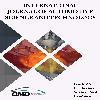The Effect of the Running Clearance to the Braking Force
The Effect of the Running Clearance to the Braking Force
Air disc brake, automatic adjuster, braking force, running clearance,
___
- [1] Limpert, R. Brake design and safety Third Edition, SAE; 2011.
- [2] Day AJ, Bryant D. Braking of road vehicles. Butterworth-Heinemann; 2022 Mar 21.
- [3] Tagesson K. Truck steering system and driver interaction. Chalmers Tekniska Hogskola (Sweden); 2014.
- [4] Tagesson K, Cole D. Advanced emergency braking under split friction conditions and the influence of a destabilising steering wheel torque. Vehicle system dynamics. 2017 Jul 3;55(7):970-94.
- [5] Guntay B, Taşınabilir fren dinamiği inceleme cihazı tasarımı ve yazılımı [MSc Thesis]. Ege University, İzmir; 2019.
- [6] Shridhare, M., Sonar, S., Ranawat, M. and Jindal, A., Estima-tion and reduction of lateral deviation (brake pulling) of a vehi-cle due to difference in left and right wheel brake force, SAE Technical Paper, 2017
- [7] Tretsiak D, Ivanov V. Investigation on hysteresis losses into disc brake gear for heavy vehicles. SAE paper. 2006 Oct 8:01-3212.
- [8] Henock A. Design Improvement On The Brake Clearance Adjust-ment Of Sino-Truck (Doctoral dissertation).
- [9] Tamasho T, Doi K, Hamabe T, Koshimizu N, Suzuki S. Technique for reducing brake drag torque in the non-braking mode. JSAE re-view. 2000 Jan 1;21(1):67-72.
- [10] Antaaitis DB. Vehicle Level Brake Drag Target Setting for EPA Fuel Economy Certification. SAE International Journal of Passen-ger Cars-Mechanical Systems. 2016 Sep 18;9(2016-01-1925):1157-71.
- [11] Maintenance Manual no. MM-0350 ELSA 195/225 Reaction Beam Air Disc Brake; 2009.
- [12] Corminboeuf D. Calibration of bridge standard for strain gauge bridge amplifier. In17th International Congress of Metrology 2015 (p. 04004). EDP Sciences.
- [13] D’Emilia G, Gaspari A, Iavicoli C, Natale E. Measurement uncer-tainty estimation of gap and profile in the automotive sector. In-Journal of Physics: Conference Series 2020 Jul 1 (Vol. 1589, No. 1, p. 012017). IOP Publishing.
- Yayın Aralığı: 4
- Başlangıç: 2016
- Yayıncı: Otomotiv Mühendisleri Derneği
Design and Crashworthiness Analysis of Rear Underrun Protection Device
Quasi-Realistic Performance Analysis of Modern Atkinson Cycle
A. Onur ÖZDEMİR, Latif Kasım UYSAL, Regaip MENKÜÇ, Emre ARABACI
An Investigation of Punch Radius and Clearance Effects on the Sheet Metal Blanking Process
Tensile Strength of Adhesively Bonded and Hybrid (Bonded/Riveted) Dissimilar Single-Lap Joints
The Effect of the Running Clearance to the Braking Force
Bora GÜNTAY, Aysun BALTACI, Cihan KİREÇÇİ, Özgün Cem YILMAZ, Oğuz GÜRSES
A Novel Engine Vibration Measurement System based on the MEMS Sensor
Investigation on Different Driving Cycle and Scenarios Considering the Autonomous Electric Vehicles
Uğur DEMİR, Zeliha KAMIŞ KOCABIÇAK
A Reliability-Enhanced Forming Grinding Method of Cylindrical Involute Gears for Electrical Vehicles
